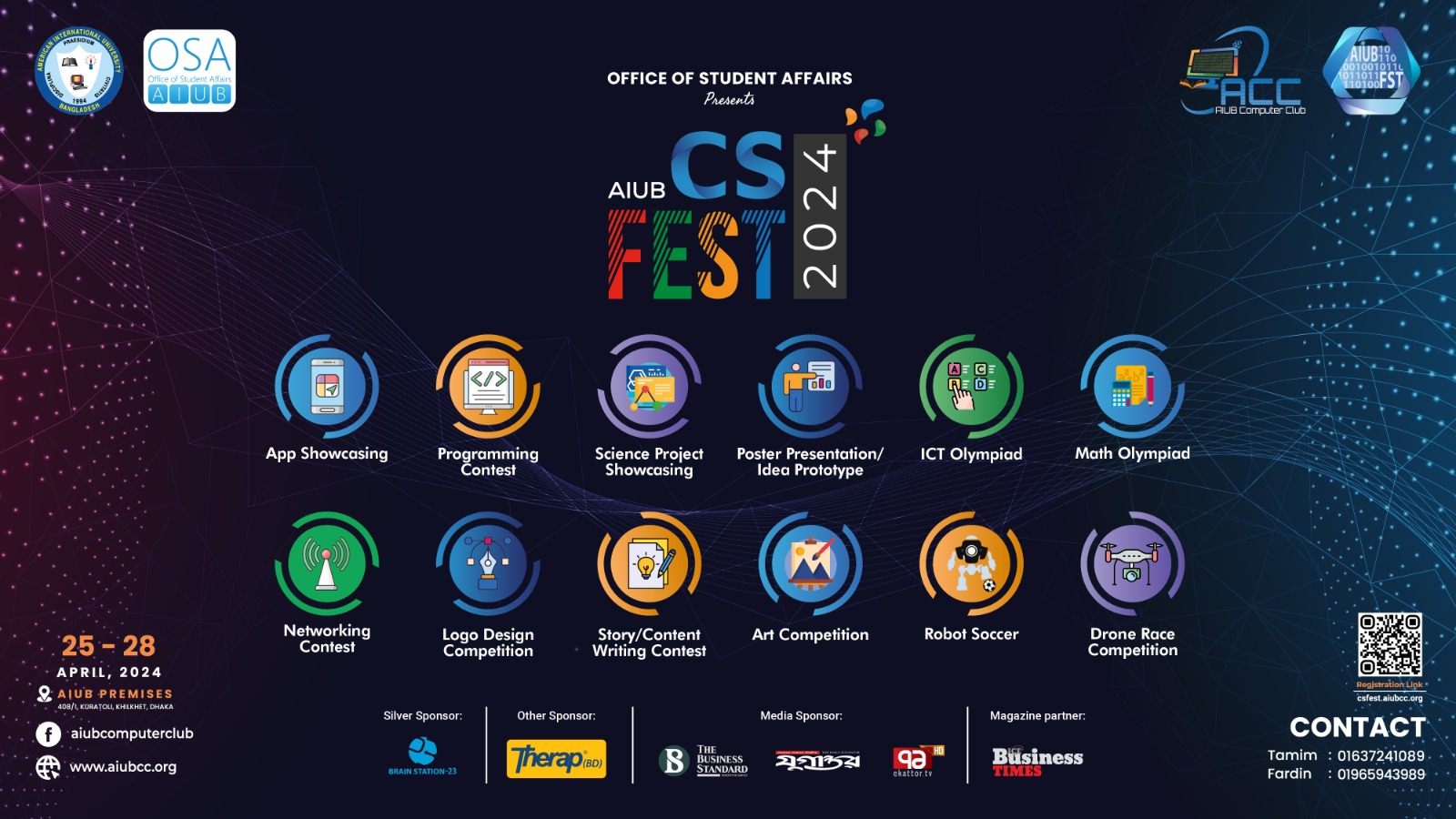By Mohammad Kashif Choudhury
Backdrop of the State of University-Industry Synthesis
During the year 2019, Asif Chowdhury, a business graduate of a top-15 private university in Bangladesh, like thousands of his batch mates, is on his way to his dream job at one of the premiere conglomerates in Bangladesh, where he will work as a business development manager with multiple roles ranging from products to marketing to project management. He got the job after his university facilitated an internship at the company during his 3rd year. He also received an edge from taking the standardized, mandatory English communications course mandated by the UGC and the elective course CS50 (Introduction to Computer Science, which Harvard University freely distributes and supports) offered from his university on the flipped classroom model.
This story may seem unrealistic, but provided we use the potential, initiative, opportunities and human resources at our disposal, it may indeed come to fruition by the time Asif graduates (remember, it’s still 2017 so him and his friends are still only in their 2nd year so we still have time).
As it stands however, we are far from this reality. Even though Bangladesh is steaming ahead at full speed towards middle income status, prosperity and substantially improved standards of living, it is facing a severe shortage of university graduates with the right skills in jobs ranging from management to marketing to finance to product development and project management. This is compelling the country to rely on around 500,000 expatriate white collar workers, costing the country foreign currency outflows of more than $5 billion every year.
Macro-economy is on the upswing but has to be maintained
If the skills gap is left unchecked, this problem will only get worse as the GDP grows at more than 6.5% per annum, crossing $200 billion, exports exceeding $35 billion, remittances at around $15 billion and foreign exchange reserves in excess of $30 billion (more than enough to pay for 9 months’ of import payments).
Its growth is projected to be competitive with regional peers, exceeding that of Vietnam, Pakistan and China and close behind India. Even though the peer group has a higher GDP base than Bangladesh, these trends point to a convergence if growth is sustained.
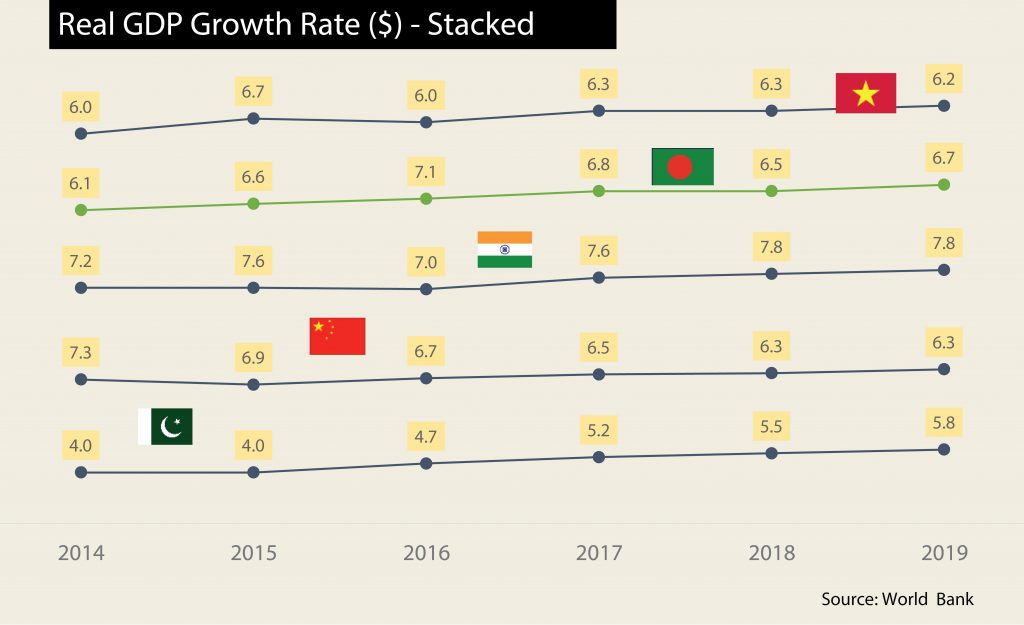
The industrial engine is firing on all cylinders
The engine behind Bangladesh’s growth is comprised of the agricultural, manufacturing and services sectors. Even though the agricultural sector is the largest sector in terms of employment, it is the third biggest component in terms of value generated with a 16% share of GDP. The manufacturing sector comprises 30% and the services sector makes up the remaining 54%.
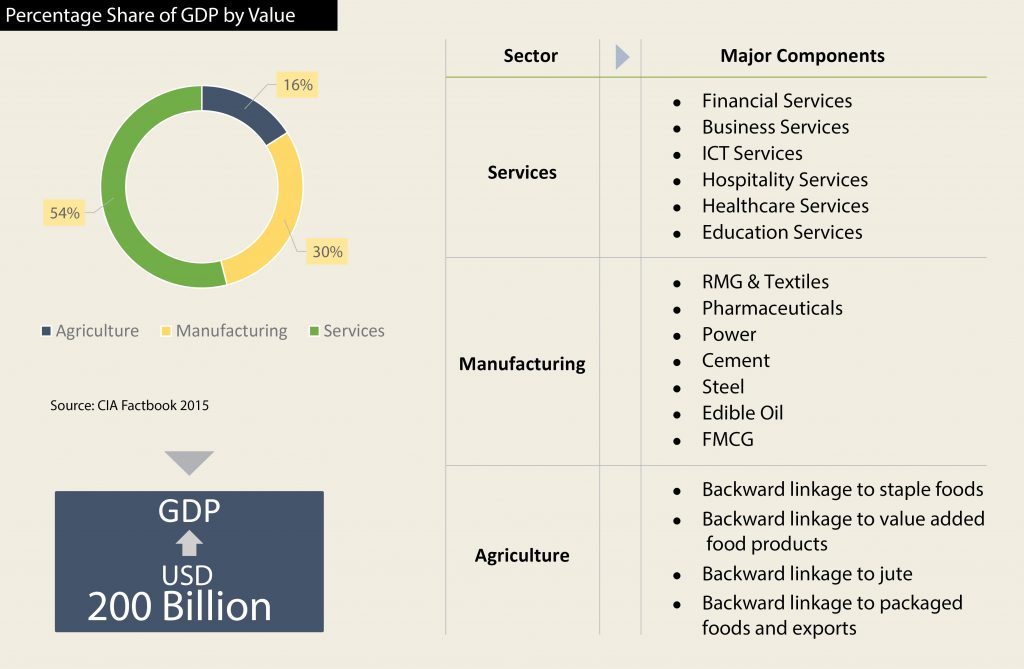
However, the engine needs skilled hands to power it
In order for Bangladesh to continue on its growth path, it needs the brains of its youth to fire on all cylinders. As it stands, the demand for skilled manpower far outstrips supply – not in numbers, but in job/skill fit. There are 3.2 million students enrolled in tertiary education currently with hundreds of thousands coming into the workforce every year and they are expected to make up the majority of the labor force in the foreseeable future.
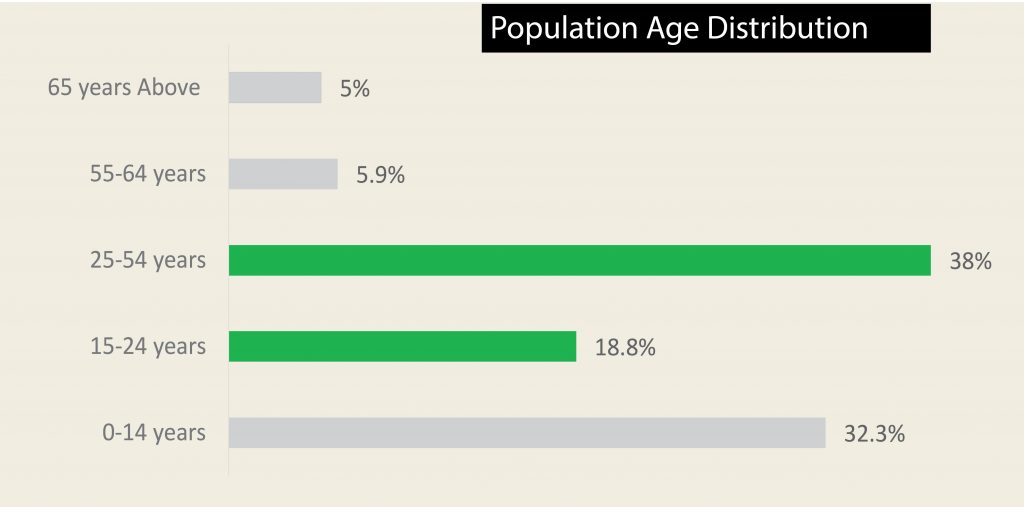
Even though nearly 200,000 people join the labor force each year, the need for human capital remains ever present– stunting economic growth and forcing thousands into underemployment due to lack of skills. As the diagram above shows, Bangladesh’s labor force participation rate has remained strong over the years, but is lower than that of its peer country, Vietnam. Moreover, the tertiary educated students who are joining the workforce are often ill prepared to deal with the realities of life outside the university campus, with below average levels of problem solving ability, subpar learning abilities, lack of confidence and communication skills and an overall lack of analytical sense. The reasons for this are multifaceted and are thoroughly explored below.
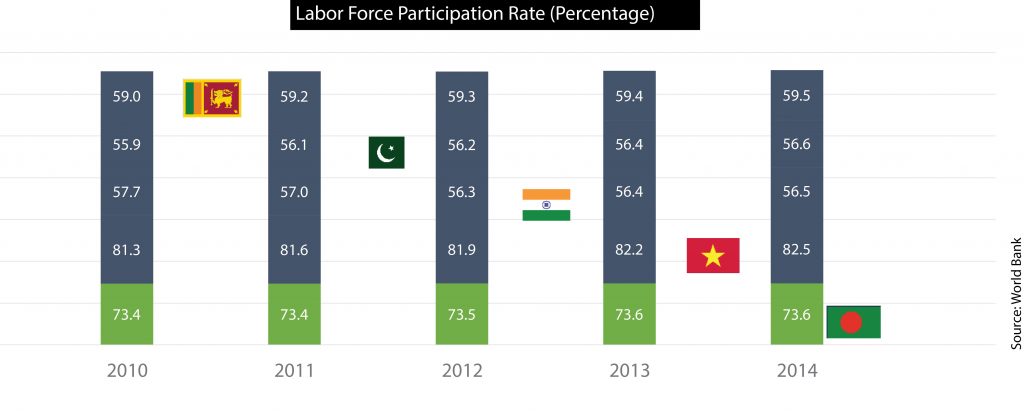
While at a university, students are largely “shielded” from the job market until they graduate. This means that even though Bangladesh produces hundreds of thousands of graduates every year, they do not come equipped with the skills that companies look for. A lack of practical experience, exposure to real world problem solving assignments and a lack of willingness from both universities and companies to invest sustained time and money to foster increased communication are compounding the problem.
There are limited efforts by academia and industry to foster connection, culminating in business and coding competitions to hire promising graduates. Some big name business competitions include Battle of Minds by British American Tobacco, Bizmaestros by Unilver, Brandwitz by Institute of Business Administration, Dhaka University. Additionally, there are occasional career fairs, on campus recruitments, unstructured alumni outreach and occasional guest lectures in the universities. However, all this is proving insufficient to address the wide academia – industry rift that has emerged over the years. Something different is needed. Something radically different.
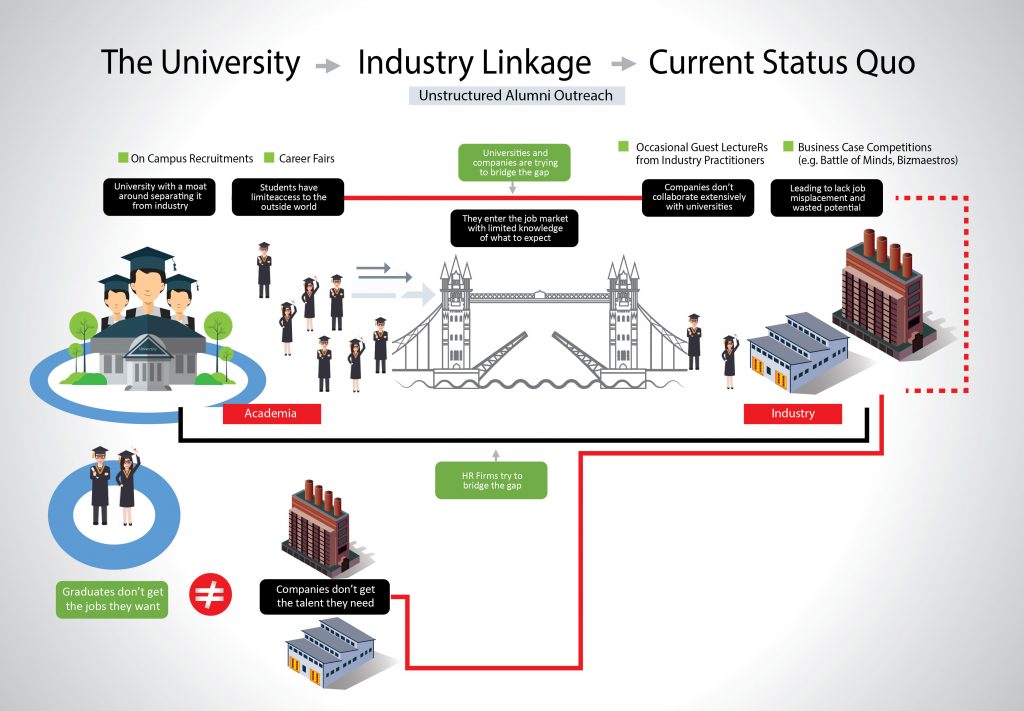
The Core Problem
The fundamental reason for the massive gap between academia and industry is a lack of understanding for the needs of the job market by academia. Many academics still consider themselves to be purveyors of knowledge first and as a means for jobs second. However, most students and employers view the university as the rite of passage to careers and this creates a mismatch between what industries need and what universities offer and it rears its ugly face once students get to the job market.
The expectations gap between academia and industry can be broken down into 3 components.
- Lack of understanding of industry needs by universities
Universities provide students with knowledge and skills that are often incompatible with the jobs they apply for. Whereas, companies demand analytical ability, problem solving experience, fluid verbal/non-verbal communication (especially in English), and the ability to learn, universities teach students often outdated theory, test them on written communication and generally teach to the test – skills that are not conducive to real world work situations in most industries.This is leading to business graduates being unemployed, pharmaceutical graduates working in administrative positions, engineering graduates working in marketing and a whole host of similar misallocations of talent. This, in spite of the fact that industries need talent more than ever, with increasing domestic consumption and international demand for Bangladesh’s exports.The most severe crunch is being felt in the following industries: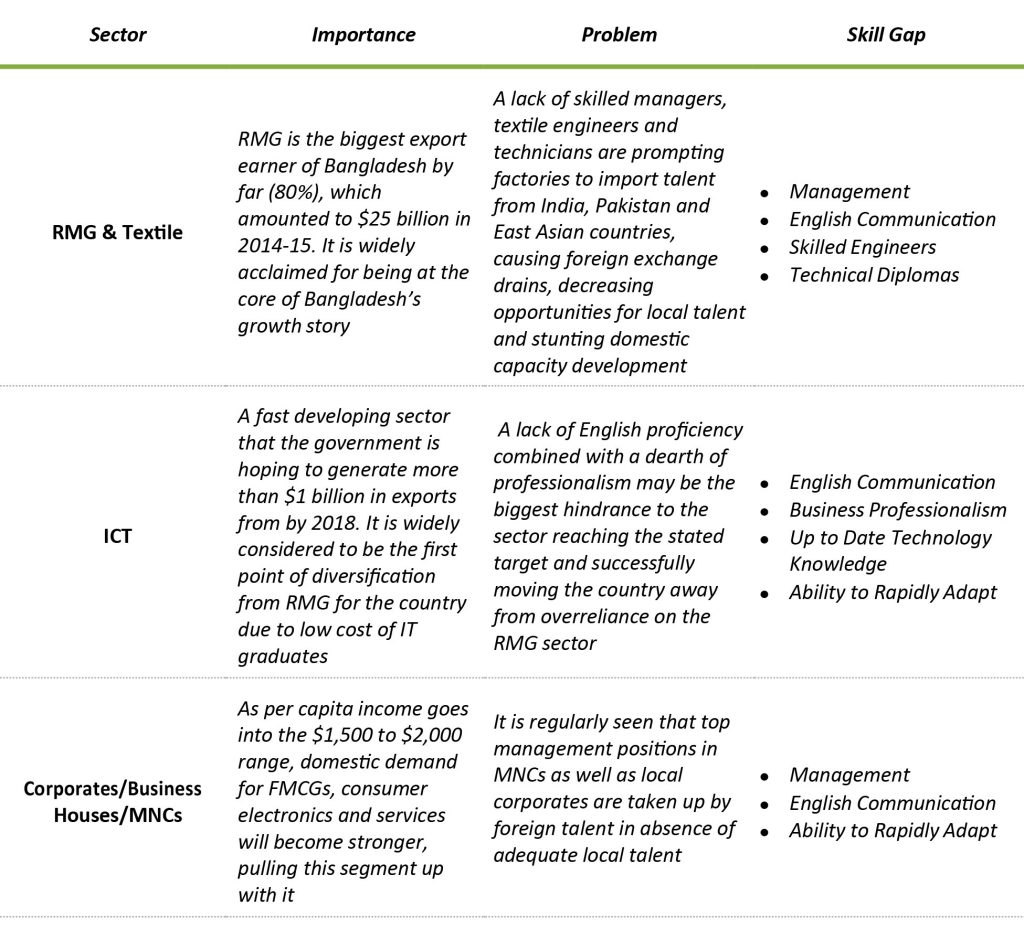
- Knowledge Based VS Application Based Learning
“A thousand year old sector that has resisted all attempts at change”. Perhaps this definition of universities is not far from the truth. Once bastions of knowledge, these institutions are facing their biggest challenge yet and may be forced to finally change according to the times. This has been further necessitated by the fact that nowadays, people have all human knowledge freely available to them at their fingertips through the internet.
This calls for universities to become centers of knowledge application, rather than knowledge dissemination. As a recent E&Y report on Australian universities stated, “Our primary hypothesis is that the dominant university model in Australia — a broad-based teaching and research institution, supported by a large asset base and a large, predominantly in-house back office — will prove unviable in all but a few cases over the next 10-15 years. At a minimum, incumbent universities will need to significantly streamline their operations and asset base, at the same time as incorporating new teaching and learning delivery mechanisms, a diffusion of channels to market, and stakeholder expectations for increased impact.” - Lack of Structured Collaboration Approaches by Both Sides
There is a lack of structured and continuous collaboration between universities and industries on the student front. Career fairs, alumni reach outs, business case competitions, guest lectures from practitioners and on campus recruitments are executed on a periodic basis, with one sporadic event not being able to build on another.
The Solution to the Mismatch between Graduate Skills and Job Requirements
A multifaceted approach has to be implemented in order to close the gap between industry and academia, with initiatives from both segments. Overall, a system has to be set up where there’s continuous flow of information and communication between students and prospective employers through a structured regime of internships, mandatory industry involvement in courses and collaborations with industries to design effective curriculums which will be effective at the workplace.
Top universities around the world like the National University of Singapore (NUS), Indian Institute of Technology (IIT), Stanford and many others have honed their ability to collaborate with industry stakeholders and position themselves as strong and steady sources of talent for the top companies of the world.
Some of the steps that have to be implemented in order for Bangladeshi universities to follow suit are as follows.
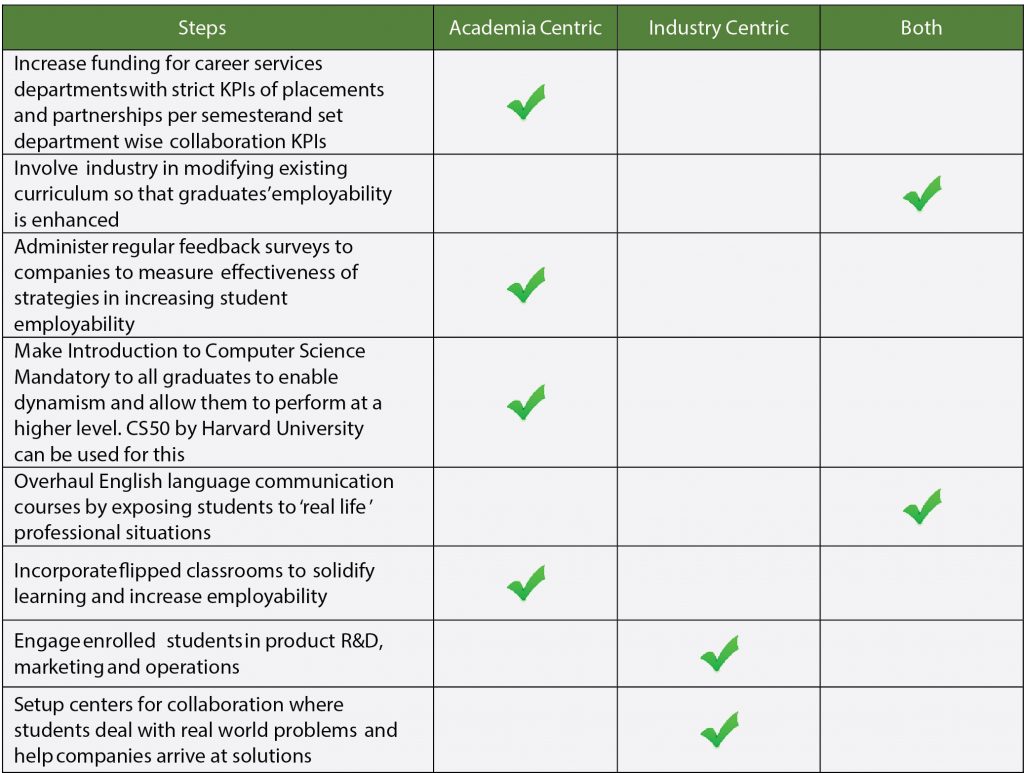
These steps will fulfill the integrated approach to academia – industry collaboration and allow both students and companies to thrive, driving Bangladesh forward into prosperity










